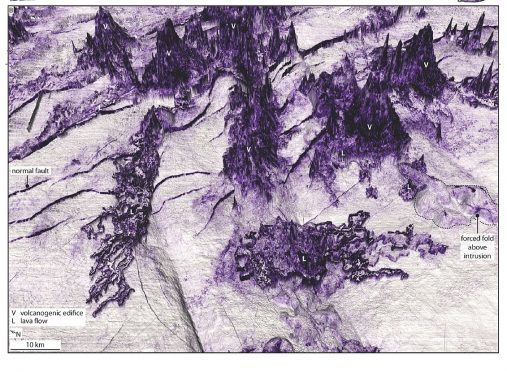Scottish scientists who delved into the depths of the sea have discovered a spellbinding Lord of the Rings style landscape off the coast of Australia.
Researchers used cutting-edge technology to investigate the seabed and found it resembled the evil realm of Mordor imagined by author JRR Tolkien.
Using brand new 3D seismic reflection data, the team found jagged peaks, outcrops and ancient volcanoes buried deep underneath the sediment of the Great Australian Bight basin.
Their research is the first in the world to reveal this dramatic hidden landscape.
A total of 26 buried lava flows have been uncovered, some measuring up to 21 miles in length and 9 miles wide.
The largest has an area of 189 square miles – making it bigger than Malta, Liechtenstein and Monaco combined.
Many of these flows are associated with a “multitude” of volcanoes as tall as 2,000ft, created from eruptions under the sea off southern Australia about 35 million years ago.
The study was co-authored by Nick Schofield from Aberdeen University’s school of geosciences, who said: “By using data acquired as part of oil exploration efforts, we have been able to map these ancient lava flows in unprecedented detail, revealing a spectacular volcanic landscape that brings to mind illustrations from Lord of the Rings.”
The research was conducted in conjunction with Adelaide University and the Commonwealth Scientific and Industrial Research Organisation (CSIRO).
It has now been published in the American Geophysical Union Journal and will be used to improve scientists’ understanding of how volcanoes evolve when they erupt underwater.
Mr Schofield added: “Submarine lava flows are inherently more difficult to study than their counterparts on the Earth’s surface due to their inaccessibility, and the technology we have used is similar in many ways to what is used to produce ultrasound images of babies, but for the Earth.
“By using this technique, we have a unique insight into a landscape that has remained hidden for millions of years, highlighting the growing importance of seismic data in studying submarine volcanism.”










